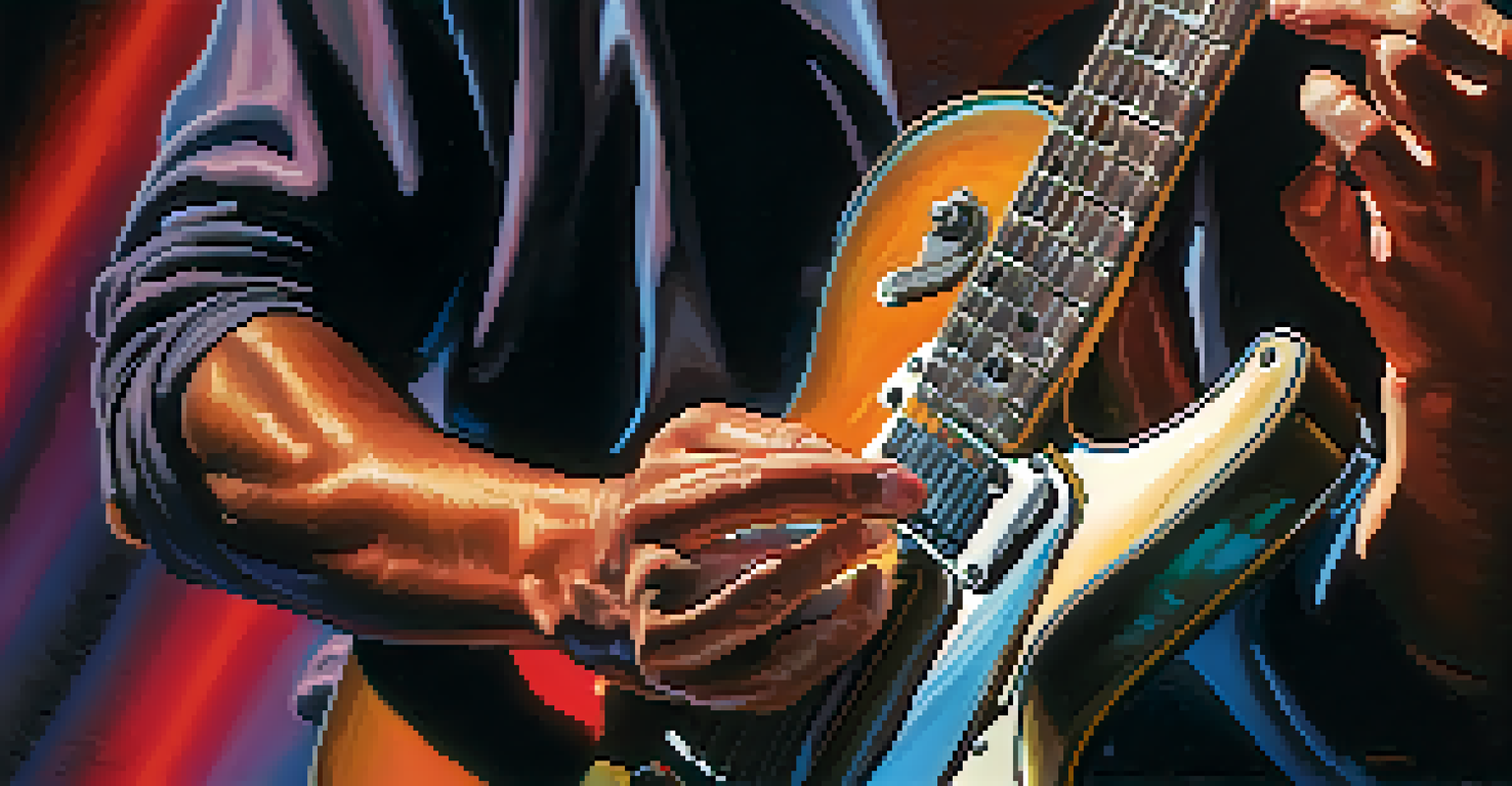Guitar-Driven Narratives: Case Studies of Iconic Songs

The Power of Storytelling in Music
Music has always been a powerful medium for storytelling, and guitar-driven songs often take center stage. The emotive quality of the guitar can paint vivid pictures and evoke deep feelings, making the narrative resonate with listeners. For instance, a simple strumming pattern can set a scene, while a soaring solo can express the character's inner turmoil. This blend of melody and lyrics creates an immersive experience that connects the audience to the song's story.
Music is the shorthand of emotion.
Think about how a song like 'Fast Car' by Tracy Chapman uses the guitar to drive its narrative. The gentle yet poignant strumming complements the lyrics about dreams and escape, immersing listeners in the protagonist's journey. This synergy between guitar and lyrics exemplifies how musicians harness the instrument to enhance storytelling. Ultimately, the guitar becomes a vital character in the tale, enriching the overall narrative.
In essence, guitar-driven narratives serve as a bridge between the artist's emotions and the listener's experiences. They invite us to reflect on our own stories while engaging with the universal themes of love, loss, and aspiration. As we explore iconic songs, we'll uncover how this creative partnership between guitar and narrative creates timeless classics.
Bob Dylan: The Poet of the Six-String
Bob Dylan is often celebrated as one of the greatest songwriters, and his guitar work is a crucial element of his storytelling. With songs like 'Blowin' in the Wind,' Dylan uses simple chord progressions that allow his poignant lyrics to shine. The acoustic guitar's folk roots complement his reflective verses, inviting listeners to ponder the profound questions he raises. Dylan's ability to weave social commentary into his music makes his narratives resonate even today.

Take 'Like a Rolling Stone,' for example. The electric guitar riffs set a raw, rebellious tone that matches the song's themes of disillusionment and freedom. Dylan's vocal delivery, paired with the driving guitar, transforms the narrative into an anthem of transformation. This synergy showcases how the guitar not only supports the lyrics but also elevates the entire storytelling experience.
Storytelling Through Guitar
Guitar-driven songs create an immersive narrative experience by blending melody and lyrics to evoke deep emotions.
Dylan's work illustrates the profound impact of guitar-driven narratives in folk and rock music. By merging poetic lyrics with compelling guitar melodies, he invites listeners into a world of reflection and rebellion. His songs remind us that the guitar can be a powerful vehicle for conveying complex human emotions and societal issues.
The Rolling Stones: Rock 'n' Roll Rebels
When we think of guitar-driven narratives, The Rolling Stones immediately come to mind. Their iconic hit 'Paint It Black' features a haunting sitar riff that draws listeners into its dark narrative. The song's exploration of grief and despair is amplified by the guitar's somber tones, creating a vivid emotional landscape. This ability to intertwine guitar melodies with lyrical themes is a hallmark of their music.
The guitar is a miniature orchestra in itself.
Another standout example is 'Angie,' where the acoustic guitar gently supports a narrative of love and longing. The interplay between the delicate fingerpicking and Mick Jagger's heartfelt vocals creates an intimate atmosphere. This combination allows the listener to feel the weight of the story without overwhelming them, showcasing the art of subtlety in guitar-driven compositions.
The Rolling Stones masterfully use the guitar to enhance their storytelling, making their songs resonate across generations. Each riff and chord progression not only tells a story but also evokes a strong emotional response. Their legacy underscores the significance of guitar in shaping the narrative landscape of rock music.
Nirvana: The Voice of a Generation
Nirvana's music is synonymous with the grunge movement, and their guitar-driven narratives capture the angst of a generation. With songs like 'Smells Like Teen Spirit,' Kurt Cobain's raw guitar riffs convey a sense of rebellion and disillusionment. The juxtaposition of heavy distortion and melodic hooks creates a sound that mirrors the lyrics' themes of apathy and frustration. This powerful combination invites listeners to connect with the emotional weight of the narrative.
In 'Come As You Are,' the guitar’s laid-back riff contrasts with the song's underlying themes of identity and acceptance. Cobain's whispery vocals add a layer of intimacy, encouraging listeners to reflect on their own struggles. This blend of heavy and soft elements showcases how Nirvana used the guitar to navigate complex emotional landscapes, making their narratives relatable and impactful.
Iconic Artists and Their Narratives
Artists like Bob Dylan and Taylor Swift utilize guitar to enhance their storytelling, making their themes relatable and impactful.
Nirvana's ability to articulate the feelings of an entire generation through their guitar-driven narratives solidified their place in music history. Their songs continue to resonate, reminding us of the power of storytelling in rock music. By harnessing the guitar to express raw emotions, they created a legacy that still influences artists today.
Fleetwood Mac: Harmony and Heartbreak
Fleetwood Mac's 'Go Your Own Way' is a prime example of how guitar-driven narratives can explore complex relationships. The song's driving rhythm and soaring guitar solos powerfully express the turmoil of a breakup. Lindsey Buckingham's guitar work complements the emotional weight of the lyrics, creating an anthem of both heartache and liberation. This intricate relationship between guitar and narrative showcases the band's dynamic storytelling ability.
Another iconic track, 'Landslide,' features delicate fingerpicking that reflects vulnerability and introspection. Stevie Nicks' haunting vocals paired with the gentle guitar create a sense of nostalgia, inviting listeners to reflect on their own life journeys. This blend of narrative and melody illustrates how Fleetwood Mac expertly captures the complexities of love and growth through their music.
Through their guitar-driven narratives, Fleetwood Mac explores themes of love, loss, and personal evolution. Their ability to intertwine heartfelt lyrics with captivating melodies creates songs that resonate deeply with listeners. This craftsmanship is a testament to the enduring power of the guitar in storytelling.
Taylor Swift: Modern-Day Storyteller
Taylor Swift has emerged as one of the most influential songwriters of her generation, often using the guitar as a storytelling tool. In 'All Too Well,' she masterfully blends vivid imagery with compelling guitar melodies, creating a narrative that feels both personal and universal. The acoustic guitar's gentle strumming allows listeners to immerse themselves in the emotional landscape of her recollections. Swift's storytelling ability shines as she captures the intricacies of love and heartbreak.
In contrast, songs like 'Blank Space' showcase her pop sensibilities while still maintaining strong narratives. The guitar riff in this track adds an edge to the story of romance and self-awareness, highlighting her versatility as a songwriter. Swift's ability to switch between genres while keeping her narratives engaging demonstrates the guitar's adaptability in modern music.
Emotional Power of the Guitar
The guitar acts as both a storyteller and a character, enriching narratives and connecting listeners to complex emotions.
Through her guitar-driven narratives, Taylor Swift has redefined storytelling in contemporary music. Her songs resonate with listeners of all ages, proving that the guitar remains a powerful instrument for expressing complex emotions. Swift's work exemplifies how the guitar can bridge the gap between personal experiences and universal themes.
The Intersection of Guitar and Emotion
At the heart of guitar-driven narratives lies the intersection of music and emotion. Guitars have a unique ability to convey feelings that words alone often cannot express. This emotional resonance is evident in countless iconic songs, where the guitar serves as a conduit for the artist's innermost thoughts. Whether it's the joy of love or the pain of loss, the guitar amplifies these sentiments, making the narrative even more compelling.
Consider how a simple chord change can evoke a sense of nostalgia or urgency, guiding the listener through the story. Artists like Eric Clapton and Jimi Hendrix have mastered this art, using their guitar skills to enhance their lyrical themes. Their ability to translate emotion into sound is what sets guitar-driven narratives apart from other musical forms.

Ultimately, the guitar acts as both a storyteller and a character in these narratives, enriching the overall experience. By tapping into the emotional power of the guitar, songwriters can create memorable stories that resonate long after the music has stopped. This connection between guitar and emotion is what makes the world of music so captivating.
Conclusion: The Enduring Legacy of Guitar Narratives
As we reflect on the impact of guitar-driven narratives, it's clear that they hold a special place in music history. Iconic songs have the power to transport us to different times and places, thanks to the guitar's ability to enhance storytelling. From Bob Dylan's poignant lyrics to Fleetwood Mac's complex emotions, the guitar remains a vital tool for artists seeking to connect with their audience.
The versatility of the guitar allows for a wide range of narratives, from the raw energy of rock to the introspective nature of folk. This adaptability has ensured that guitar-driven stories continue to evolve, resonating with new generations of listeners. Artists like Taylor Swift and Nirvana have shown that the guitar can still be a powerful instrument for conveying contemporary themes.
Ultimately, the legacy of guitar-driven narratives is one of connection and empathy. By sharing their stories through this beloved instrument, artists invite us to reflect on our own experiences and emotions. As long as there are stories to tell, the guitar will remain an essential part of the musical landscape.